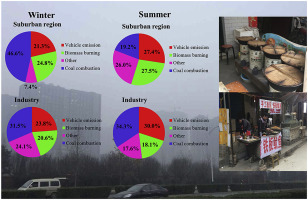Environmental Pollution ( IF 7.6 ) Pub Date : 2017-09-18 , DOI: 10.1016/j.envpol.2017.08.106 Jingzhi Wang , Junji Cao , Zhibao Dong , Benjamin Guinot , Meiling Gao , Rujin Huang , Yongming Han , Yu Huang , Steven Sai Hang Ho , Zhenxing Shen

|
Seasonal variation and spatial distribution of PM2.5 bound polycyclic aromatic hydrocarbons (PAHs) were investigated at urban residential, commercial area, university, suburban region, and industry in Xi'an, during summer and winter time at 2013. Much higher levels of total PAHs were obtained in winter. Spatial distributions by kriging interpolations principle showed that relative high PAHs were detected in western Xi'an in both summer and winter, with decreasing trends in winter from the old city wall to the 2nd-3rd ring road except for the suburban region and industry. Coefficients of diversity and statistics by SPSS method demonstrated that PAHs in suburban have significant differences (t < 0.05) with those in urban residential in both seasons. The positive Matrix Factorization (PMF) modeling indicated that biomass burning (31.1%) and vehicle emissions (35.9%) were main sources for PAHs in winter and summer in urban, which different with the suburban. The coal combustion was the main source for PAHs in suburban region, which accounted for 46.6% in winter and sharp decreased to 19.2% in summer. Scattered emissions from uncontrolled coal combustion represent an important source of PAHs in suburban in winter and there were about 135 persons in Xi'an will suffer from lung cancer for lifetime exposure at winter levels. Further studies are needed to specify the effluence of the scattered emission in suburban to the city and to develop a strategy for controlling those emissions and lighten possible health effects.
中文翻译:

西安市19个社区中多环芳烃(PAHs)的季节变化,空间分布和源分配:冬季郊区散发排放物的影响
在2013年夏季和冬季,在西安市的城市住宅区,商业区,大学,郊区和工业区调查了PM 2.5结合的多环芳烃(PAHs)的季节变化和空间分布。总PAHs含量高得多是在冬天获得的。克里格插值原理的空间分布表明,西安西部夏季和冬季均检测到相对较高的多环芳烃,从旧城墙到第二个冬季,冬季均呈下降趋势。-三环路,郊区和工业区除外。SPSS方法的多样性系数和统计数据表明,在两个季节中,郊区的PAHs与城市居民的PAHs有显着差异(t <0.05)。正矩阵分解(PMF)模型表明,冬季和夏季城市中PAH的主要来源是生物质燃烧(31.1%)和车辆排放(35.9%),这与郊区有所不同。燃煤是郊区多环芳烃的主要来源,冬季占PAHs的46.6%,夏季急剧下降到19.2%。不受控制的燃煤散发的排放物是冬季郊区郊区多环芳烃的重要来源,西安市约有135人因在冬季暴露于一生而罹患肺癌。











































 京公网安备 11010802027423号
京公网安备 11010802027423号